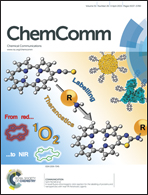A facile photopolymerization method for fabrication of pH and light dual reversible stimuli-responsive surfaces†
Abstract
Dual reversible surfaces with pH and light responsive properties were prepared via two-stage photopolymerization by grafting dimethylaminoethyl methacrylate (DMAEMA) and 2-methyl-4-phenylazo acrylate (MPA-Azo) on a substrate. The wettability of the modified surface could be reversibly controlled because of the protonation and deprotonation of DMAEMA at different pH values and the photoisomerization of MPA-Azo under UV irradiation at different wavelengths. This facile two-stage photopolymerization method has potential applications in fabrication of various external stimuli-responsive surfaces in the future.


 Please wait while we load your content...
Please wait while we load your content...